What Does Salmon Taste Like?
When you buy through our links, The Breslin may earn an affiliate commission. Learn more
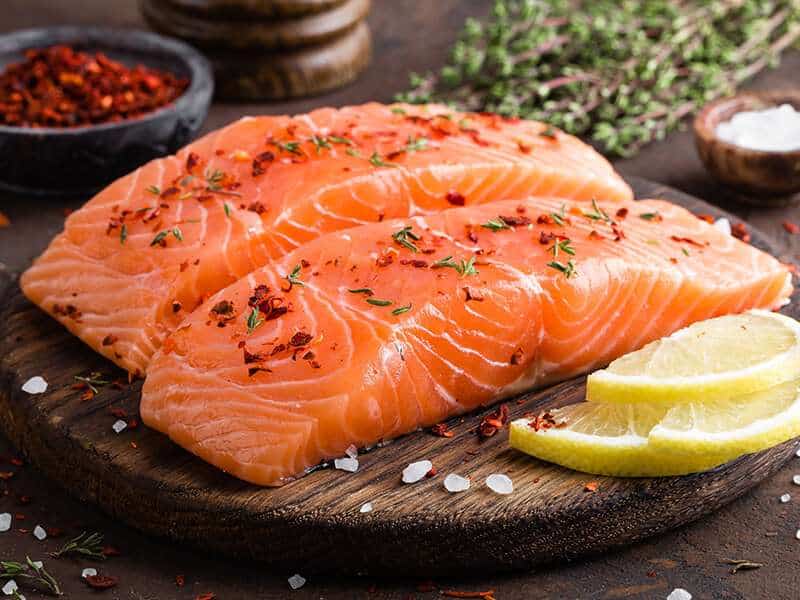
What does salmon taste like? It seems like everyone knows about salmon, but not everyone has ever tasted it. You might have heard someone tell you about the taste of this fish before, like: “fishy,” “tender,” or “fatty.” Yes. That’s true. But the salmon taste is much more than that.
Salmon is not the name of one fish but the common name of several fish species. Therefore, its taste will be more complex than the others. In this post, I’ll tell you not only about the taste of salmon, but also other necessary information as detailed as possible!
What are you waiting for? Let’s get started!
What Does Salmon Taste Like?
“What does salmon taste like?”
Well, it will be a big challenge for me to shortly describe salmon’s taste in just a few sentences because different kinds of salmon will have different tastes:
- Chinook Salmon: Strong flavor due to high fat content.
- Coho Salmon: Milder taste with moderate fat content.
- Sockeye Salmon: High fat content but with a moderate flavor.
- Humpback Salmon: Low fat content makes it taste subtle.
- Chum Salmon: Lowest fat content with neutral flavor.
- Leaper Salmon: Rich flavor and high in fat.
Moreover, the place they grow, the cooking method you use, and the season they are caught also will play an important role in building their characteristic tastes.
If you want to know the most detailed flavor profile of all salmon’s kinds, read all of this article. I’m sure it will not take so much of your time.
Salmon – The World Most Well-Loved Food
To better understand salmon’s taste, this part will show you some common information about this fish and introduce you to different kinds of salmon.
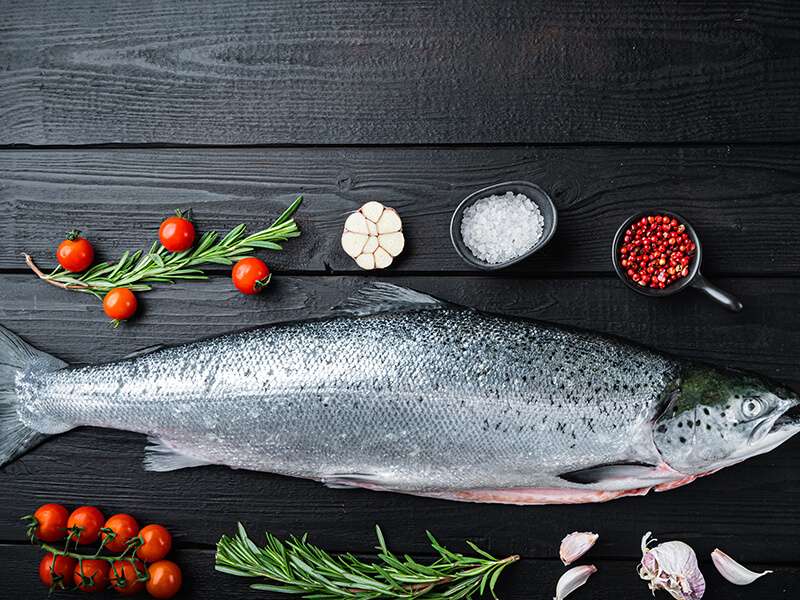
1. Salmon – What You Might Not Know
As I mentioned above, salmon is actually not the name of a fish. More exactly, it is the name used to indicate several species of fish. These species are ray-finned fish that belong to the Salmonidae family.
Salmon are believed to have originated from the North Atlantic and the Pacific Ocean, but they can be found in many other waters. Although salmon is categorized as saltwater fish, it is interesting that these fish are anadromous.
In other words, baby salmon will be born in freshwater and live there. Until the adolescence period, they will migrate to the saltwater (the ocean) and only come back in the reproduced season.
In the past, salmon was wild-caught. However, due to the increase in salmon demand, many salmon fish farms have been opened to meet that need.
Discover more interesting facts about salmon!
2. Various Kinds Of Salmons
There are six kinds of salmon in general. And every salmon will have distinctive characteristics. Read this section below for more detailed insights.
Chinook (King) Salmon
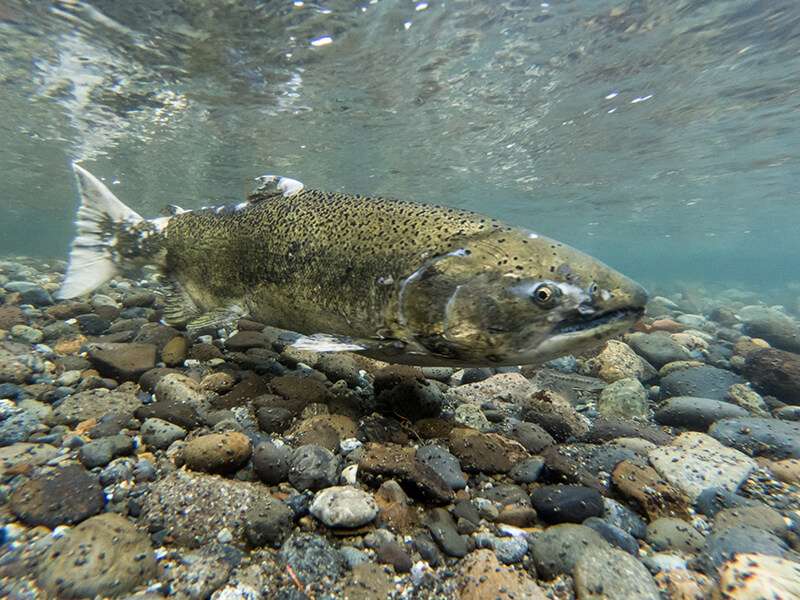
Chinook salmon, also known as King salmon, is the biggest member of the six salmon species, which can reach a length of 58 inches and weigh over 120 pounds. This salmon has purple, red, or dark greenbacks and silvery sides with black spots on their body.
Moreover, Chinook salmon are usually found in the north Pacific Ocean.
Coho (Silver) Salmon
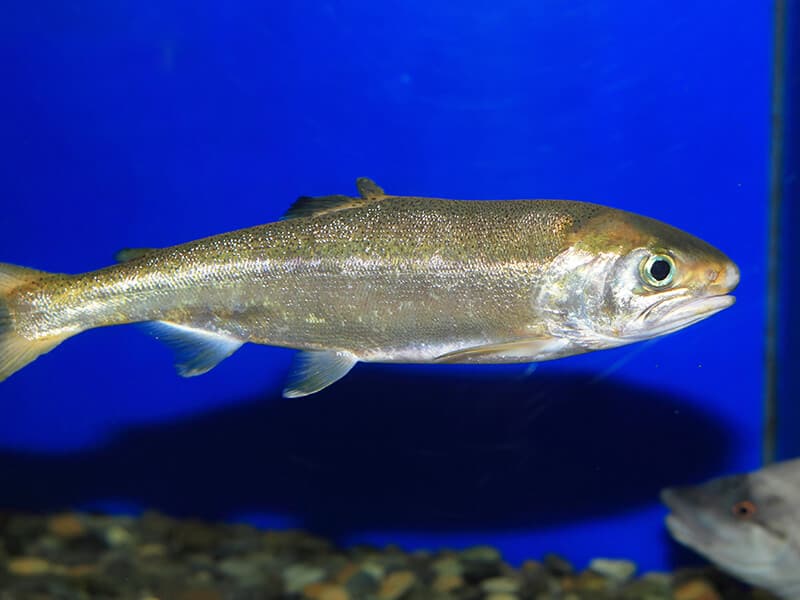
Excluding the name of Silver salmon, Coho salmon also can be called by many other names, such as Hoopid salmon or White salmon. This salmon has an average weight and length of 7 – 11 pounds and 28 inches, respectively.
And normally, Coho salmon are dark blue on the back and silver on the sides. However, after entering freshwater, their sides will automatically turn red.
Sockeye (Red) Salmon
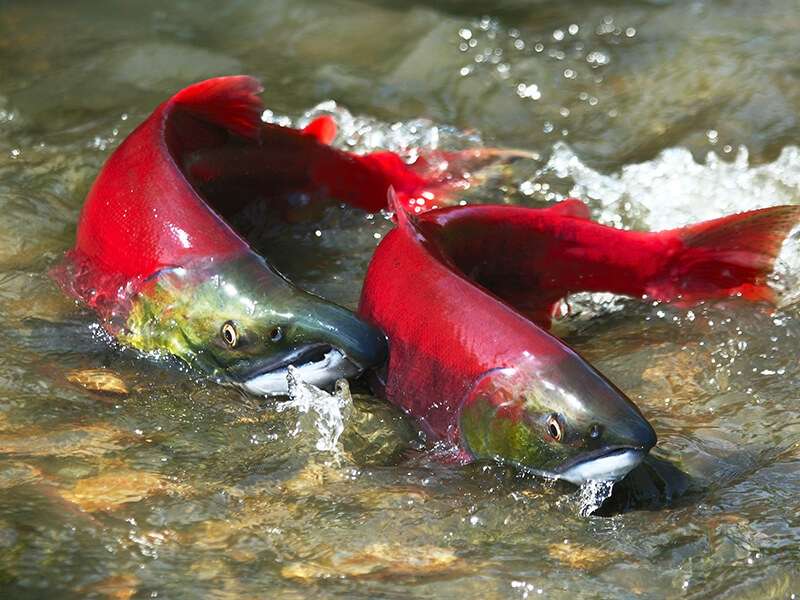
Sockeye salmon, also known as Red salmon, is the most vibrant and striking salmon. When they are born, sockeyes are usually dark blue and silvery-white, but during the reproduced season, their head turns green and their body turns vivid bright red.
Sockeye salmon can weigh up to 15 pounds and reach more than 2 feet long.
Humpback (Pink) Salmon
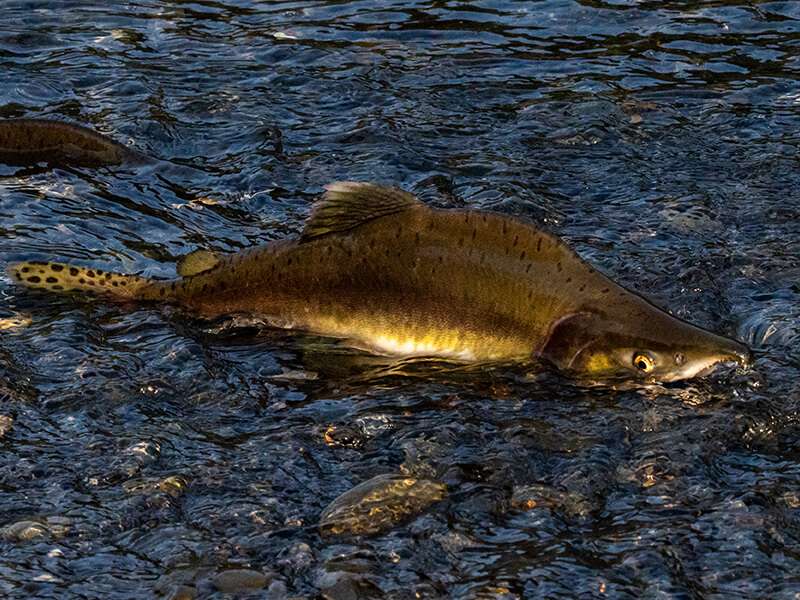
Humpback salmon, or Pink salmon, is a type of salmon found in the north Pacific Ocean. Similar to other types of salmon, Humpback salmon have a common blue and white color when they live in saltwater areas.
However, their color will also be changed once they return to freshwater regions. In addition, the length and weight of this salmon are approximately the same as sockeye salmon (about 30 inches & 15 pounds).
Chum (Dog) Salmon
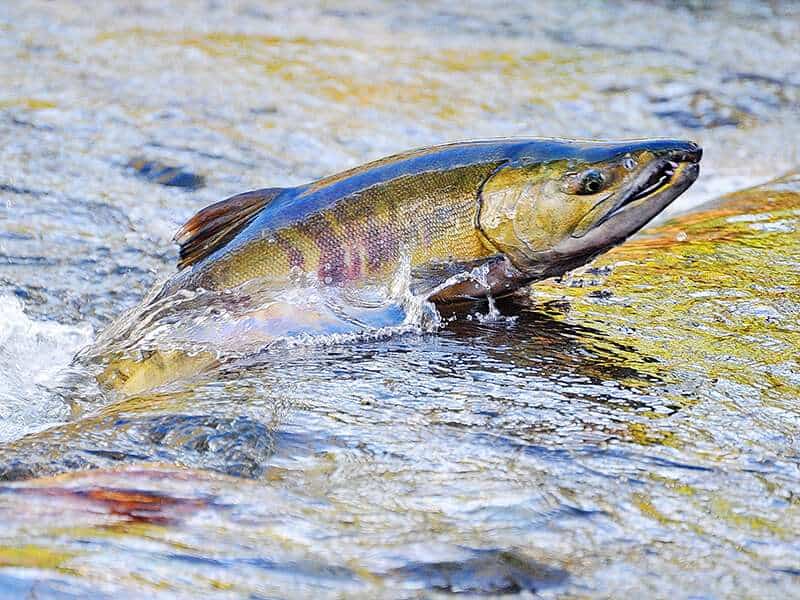
Chum salmon, aka Dog salmon, have an average weight of 9.7 – 22 pounds. However, they can reach over 42 pounds and can grow up to 44 inches long. When about to spawn, Chum salmon’s color becomes darker with reddish-purple blotchy streaks in the belly.
Leaper (Atlantic) Salmon
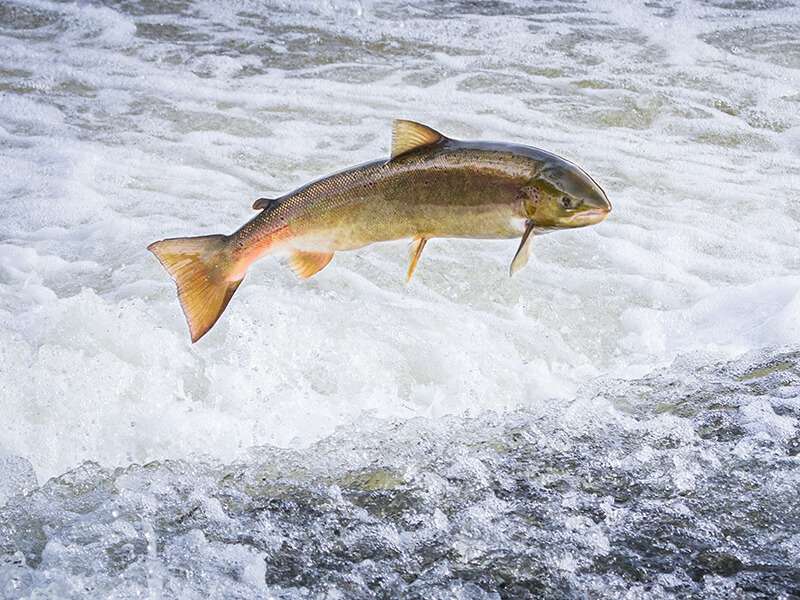
Leaper salmon (or Atlantic salmon) is commonly found in the North Atlantic. This is the most widely farmed salmon species around the world. Leaper salmon are one in three types of salmon that can reach a length of 44 inches (the others are Chinook and Chum).
And surprisingly, some of these salmon populations can live their entire lives in freshwater.
3. Salmon Uses In The Culinary World
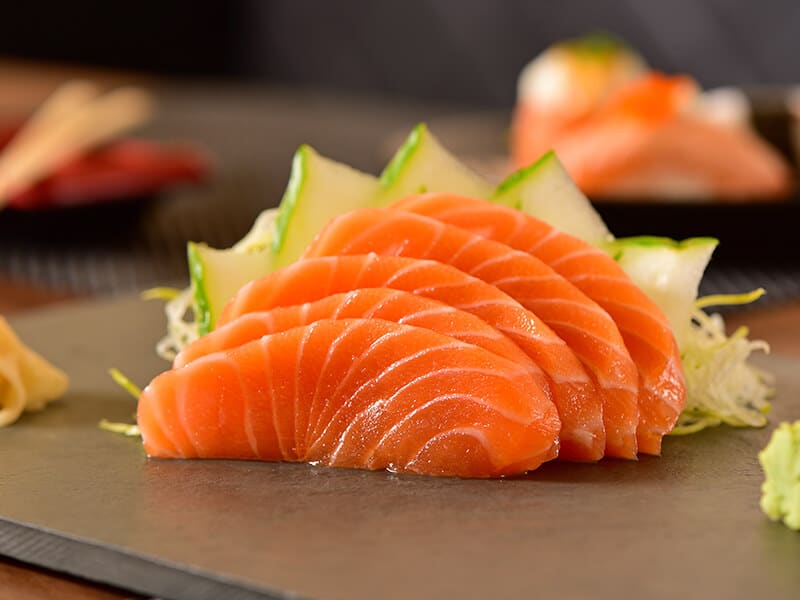
Salmon have been becoming one of the most favorite fish in the world. They are grilled, roasted, pan-fried, or even eaten raw. Whether which cooking methods you use, salmon can taste their best.
In Japanese cuisine, salmon is an iconic fish. They appear in almost all the recipes. If you are a Japanese food lover, you must have tried a lot of delicious food using this fish as a key ingredient: from sashimi, sushi to soup, rice, and hot pot.
In the Northwest water of America, salmon is called “Alaskan turkey” as this fish is abundant here. Additionally, lomi lomi salmon – a kind of salad made from fresh tomato and salmon – is always an on-trend delicacy in Hawaii.
Moreover, salmon is also highly consumed in Europe. Fresh salmon is more favored, but canned ones are also one of the indispensable items.
Tasting Profile: What Does Salmon Taste Like?
There are five main kinds of salmon. Each of them will have a distinctive flavor profile. You may confuse them sometimes, but they do have different tastes.
| Kinds Of Salmon | Taste |
| Chinook (King) Salmon | Firm, overwhelming taste with high fat content |
| Coho (Silver) Salmon | Softer, milder in texture and flavor with moderate fat content |
| Sockeye (Red) Salmon | High fat content but moderate flavor |
| Humpback (Pink) Salmon | Delighting taste with low fat content |
| Chum (Dog) Salmon | Lowest fat content and neutral flavor |
| Leaper (Atlantic) Salmon | Rich flavor and high in fat |
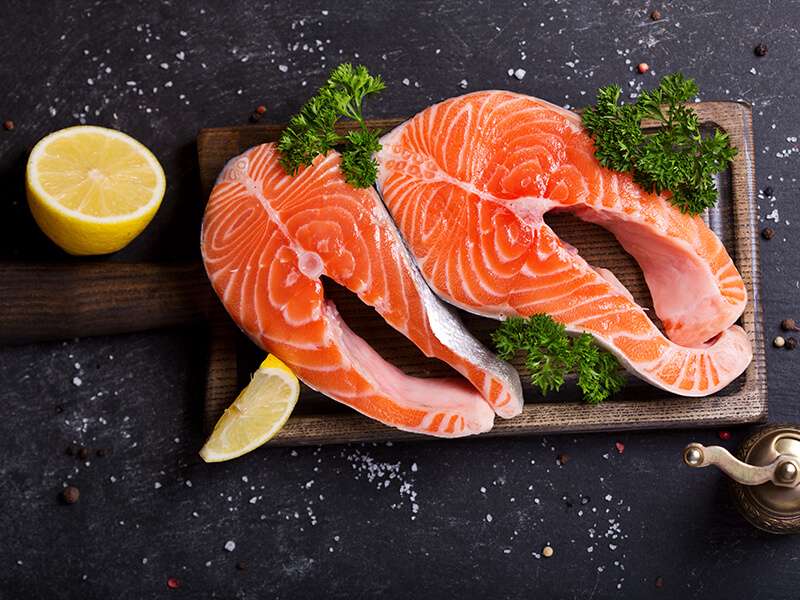
1. Chinook (King) Salmon
As their largest body size, Chinook salmon also holds the highest content of fat in their flesh. Some people may find it a little too strong. Despite that, you will not feel it fishy when eating, especially when they are cooked.
Besides, Chinook salmon is said to be the best tasting one, according to many people. And they may be your most favorite fish for grilling or roasting as the rich fat content helps them to retain a tender and firm texture without losing the juiciness.
2. Coho (Silver) Salmon
Coho salmon’s flavor is quite similar to Chinook salmon. However, they have a milder taste than the Chinook ones. Also, the fat content in Coho salmon is only at a moderate level, which makes them one of the most sought-after salmon.
Regarding the texture, Coho salmon is soft but not easy to break. Plus, this kind of salmon is served in many high-end restaurants in the world because of its less fishy smell.
3. Sockeye (Red) Salmon
Like Chinook salmon, Sockeye salmon also contains a high level of fat content. Their flavor is more intense than Coho salmon but still lighter than Chinook ones. If you want a satisfied but not overwhelming taste of salmon, go for them.
Additionally, you can easily recognize Sockeye Salmon by their distinctive vivid bright red flesh.
4. Humpback (Pink) Salmon
If you want a low-fat content salmon, do not skip out on Humpback salmon. On the other hand, Humpback salmon also has a milder taste compared to all of the other salmon. They are suitable for raw serving since their smell is delightful.
In contrast to the Sockeye salmon, Humpback salmon have a beautiful light pink flesh with an average firm texture.
5. Chum (Dog) Salmon
Chum salmon is another ideal choice for your diet too. This salmon even has lower fat content than the Humpback salmon. It can be said that they are the lowest-fat salmon you can find for your dinner.
Their taste is also neutral – not too strong and not too pale. As a result, Chum salmon is usually found in curry or fish chowder recipes.
6. Leaper (Atlantic) Salmon
Leaper salmon is high in fat. You can expect an intense taste when trying this fish too. But don’t worry, their taste is less intense when compared to Chinook salmon. They are rich, dedicated, and full of flavor without overwhelming you.
In terms of texture, Leaper salmon fillets have a medium-firm texture which is divided into large flakes.
Farmed salmon vs wild-caught salmon – Which has the better taste?
What Does Processed Salmon Taste Like?
I bet some of you may be curious about processed salmon too.
Although processed tuna, processed sardines, and other processed fish seem to be more popular, you do have the processed salmon. And, of course, the processed salmon flavor is surely somewhat different from the fresh ones as well.
| Kinds Of Processed Salmon | Taste |
| Canned Salmon | Saltier than fresh salmon with various flavors |
| Smoked Salmon | Salty taste with flaked texture |
| Pre-Packaged Salmon | Depend on the preservatives added |
1. Canned Salmon – Is It As Delicious As The Fresh Ones
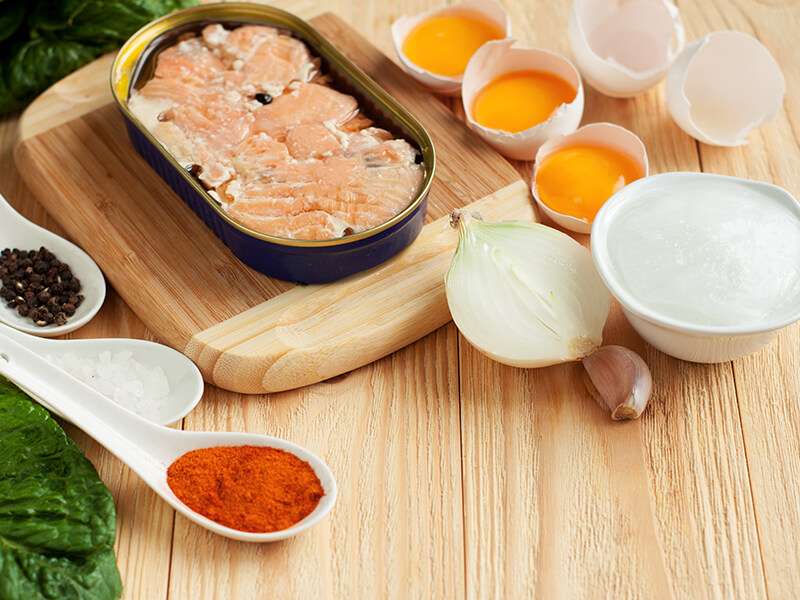
Again, depending on the salmon kind they are made from, canned salmon can be tasted differently. And it will be possible to tell the detailed flavor of each canned salmon because they are packaged and marinated with different condiments.
Salmon can be reserved in oil, water, or other sauces. And before canning, salmon often is shredded and salted for longer longevity. Hence, most of the time, you will find canned salmon tends to taste saltier than fresh ones.
2. Smoked Salmon – The Most Favored Processed Salmon
Smoked salmon is the most favorite processed salmon as it can be used versatilely in many recipes. Like canned salmon, the taste of smoked salmon depends much on the seasoning process, such as the kind of brine used and smoking methods (cold-smoked or hot smoked).
The typical used brine always has soy sauce inside with a salty taste. Moreover, some smoked salmon are very flavorful as they are marinated with extra condiments like hot sauces, pepper, lemon juice, sugar, etc.
In terms of smoking methods, cold-smoked salmon will have a fresher taste with just a small note of smoky smell while hot-smoked salmon tastes smokier with a flaked texture when eating.
3. Pre-Packaged Salmon: Complicated & Flexible Taste
The pre-packaged salmon taste is also really different from either the two processed below or fresh salmon. And it is hard to tell you a specific taste since various preservatives are added.
You can expect different flavors of pre-packaged ones based on the brand you buy and the kinds of salmon they used. But anyway, one thing you can note is that pre-packaged salmon’s taste is more complicated and flexible compared to the fresh ones.
Tips To Have Less Fishy Taste Of Salmon
If you are still hesitant about the fish taste salmon can give off, here are some tips for you. They will significantly help to remove the fishy taste of your salmon.
1. Milk Can Be Help
It might sound really weird to get your fish into milk, but it really does work! This is my favorite way since my fridge is always filled with milk. When you soak your salmon into milk, it will make your salmon become cleaner, and sweeter.
Note: 20 minutes are the best soaking time.
2. Using Lemon Juice For Cooked Salmon
In case your salmon has been cooked, squeeze some lemon juice on top. It will help to reduce the fishy smell of your salmon. In addition, it also enhances the taste, creating a more refreshing feeling.
3. Served Your Salmon With Sauce
Sauce is always the most faithful companion if your fish is unfortunately not as fresh as you wanted. Mix yogurt with lemon juice, then add some fried minced garlic and fresh chopped dill inside. They can be very helpful.
Nutritious Values & Health Benefits Behind Them
Many studies have been conducted to investigate the nutritions of salmon and what they can offer to human health. The results are abundant, and here is some evidence.
1. Omega-3 Fatty Acids Provider
Since salmon is an oily fish species, they are especially rich in omega-3 fatty acids.
According to statistics from FoodData Central, 100g of wild salmon contains 2.3 grams of long-chain omega-3 fatty acids (1) , which benefit your eye health and help to improve your cognitive function. (2)
2. They Are Rich In Protein
For optimal health, you need at least 20-30 grams of protein each meal (3) . According to the FDA, 100 grams of Atlantic salmon can provide your body with about 25 grams of protein (1). It means you don’t even need to complement any other protein-rich ingredient in your meal.
Your body really needs protein to strengthen muscle, control blood pressure and stay fit when you are older. (4)
3. Containing A Significant Amount Of Selenium
100g of wild salmon can provide your body with a significant amount of B vitamins, including vitamins B1, B2, B3, B6, B9, and B12 (1). They will help to enhance your brain activities and optimize your nervous system function. (2)
4. The Presence Of Astaxanthin
For 100g of salmon, you can find an average of 0.4–3.8 mg astaxanthin (5) . This compound has antioxidant effects, which help reduce the risk of heart disease, prevent skin damage, protect your brain and nervous system from inflammation. (2)
Choosing & Storing Fresh Salmon: Tips To Have The Excellent Taste
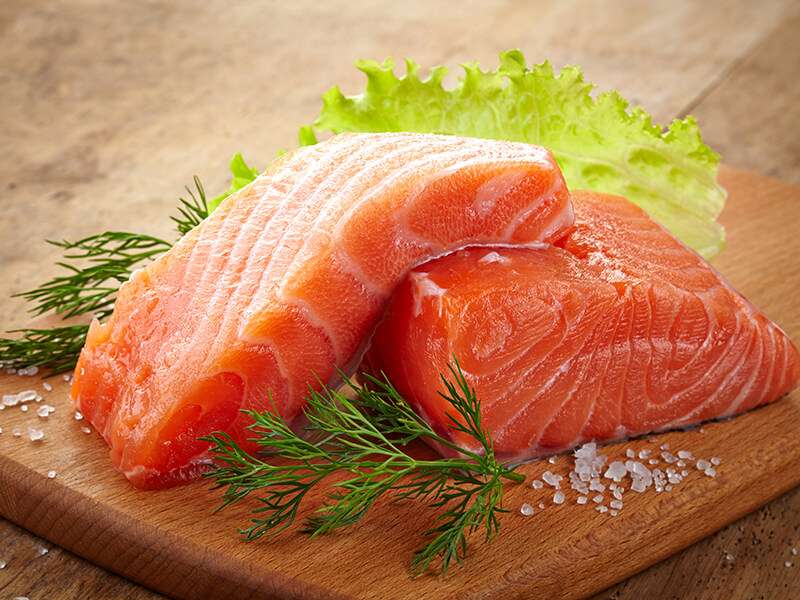
I’m sure fresh salmon is absolutely always the priority. Nevertheless, it will be hard for some of you since this might be the first time you go shopping for salmon. In this section below, I will show you how to choose the freshest salmon, and teach you how to store them too!
1. Always Choose The Freshest Salmon
Although each kind of salmon will have different characteristics, making it difficult to evaluate. However, there are still some general characteristics you can decide on.
Appearance Always Should Be Your First Consideration
First, observe the brightness of the salmon fillet in front of you. The flesh should not be too cloudy or dark. In addition, they should look shiny with fresh white fatty veins spreading in the flesh.
Note: Choose the salmon with plump, shiny, and clear eyes in case you buy the whole ones.
Avoiding Bad Smell Salmon
Salmon has a hint of fishy smell, but you need to clearly distinguish the natural fishy smell and the spoiled fish smell. Fresh salmon won’t make you feel uncomfortable, while expired or spoiled salmon do.
Be careful. Quickly step away from the ones with the bad and unpleasant smell.
Firm Texture Is A Good Indication
When choosing salmon, don’t forget to pick fillets that have a firm and smooth texture. Salmon is an oily fish, which will give off a little fat or oil in your hand after touching. Besides, if the flesh is discrete and fragile, the salmon may have been caught a long time ago.
Discover more tips for choosing the best salmon!
2. Storing Properly To Keep The Freshness
I know some of you will need some advice for storing your salmon. A good storage will help you to have delicious dishes without going to the fish store every day.
Keep Your Salmon Fresh On The Way Home
Salmon is an extremely “fragile” fish, because their flesh will easily be spoiled if not stored in cool conditions.
Hence, when buying salmon, get it home as quickly as possible. In case there are traffic jams on the way home, prepare an icebox before going to the supermarket. It will be very helpful for your salmon.
Room Temperature Is Never A Great Idea
All kinds of sea fish, including salmon, cannot be left at room temperature for over 2 hours. Storing them for too long at room temperature will speed up the spoiling time and make them lose their admired moisture.
It is better to keep your salmon in the fridge right after coming back from the fish store.
Store Your Salmon In The Fridge For 2 Days Using
The refrigerator is an ideal storage place if you don’t plan to use your salmon right away. However, there is one thing you need to keep in mind: Cook your salmon within 2 days after you brought them home.
Leaving them long in the fridge is not good for your health.
Freezer Will Be Your Best Assistant
If you want to store salmon for a longer time, put them in the freezer.
You can freeze salmon for about 2-3 months using this method. Although your salmon seems to last indefinitely in the freezer, you should eat them as soon as possible as their quality will decrease time by time.
How To Tell If Fresh Salmons Go Bad?
In their fresh version, salmon is the best-tasting fish in the world, but that is not the case when it comes to spoiled salmon. Below, I will give you four tips to figure out the spoiled salmon.
Check Out The Smell: If your salmon has gone bad, their smell will become unpleasant too. The natural characteristic fishy smell will turn into a strong and uncomfortable fishy smell. It is better to throw those salmon away and go for the new ones.
Discoloration: The clearest sign to indicate that your salmon has gone bad is discoloration. Hence, when the flesh will look grey and pale, it can either be spoiled or prone to be spoiled.
Over-Soft Fillets: Keep your eye on your salmon fillets. Once they have a discrete texture and the flesh turns to over-soft, you can consider cooking them. They are not spoiled, but they are about to be spoiled.
Cloudy Eyes: Another sign that cannot be skipped out is the salmon eyes. Remember to pick ones with clear, plump, and shiny eyes. If not, the salmon you hold may have been caught more than 5 days ago, which is going to be spoiled.
Salmon Recipes: What You Should Do With Your Salmon?
In case you are new to salmon and want to make some delicacy for your dinner, these recipes below absolutely should be added to your menu!
1. Grilled Salmon
Classic treats are never out of trend! Grilled salmon is one of the most popular ways to have the best taste of salmon. It is easy to prepare, not time-consuming but incredibly delicious. This is a recipe you should not miss on beautiful sunny days.
2. Honey Garlic Glazed Salmon
If you are looking for a simple but satisfying dish, honey garlic glazed salmon should be your top choice. Honey, soy sauce, garlic and salmon – This is a bravo combination! Don’t forget to serve it with white rice. It is definitely a double kill!
3. Teriyaki Salmon
This is a privilege for Japanese food lovers. Once you have tried teriyaki salmon, you will want to have it more the next time. You’ll be addicted to the salmon’s rich flavor and teriyaki sauce’ s sweetness. Remember the holy companions: Salmon – Rice – Asparagus!
Make teriyaki salmon with the master’s recipe!
4. Salmon Chowder
I’m sure salmon chowder is all you need on a cold Sunday night. This appetizer is definitely the coziest and most comforting food ever. I usually make it on the weekend, after a long time loaded with stressful tasks. Believe me. This delicacy will not make you disappointed!
FAQs
Now, it’s time for frequently asked questions. If you still have some confusing things, quickly scroll down to get your problems solved!
After Tasting: What Is Your Favorite Kind Of Salmon?
Salmon is diverse in kinds, which makes their taste hard to be exactly defined. You absolutely will have different experiences when tasting these fish. But no matter which kind of salmon you enjoy, the flavor never goes wrong when it comes to the freshest fillets.
I really do hope that my post has given you more useful information about salmon. And if some of you have tried salmon before, what is your most favorite taste of salmon? Which kind of salmon especially works well in your recipes?
Don’t forget to share all of your thoughts in the comment section below. I’m looking forward to hearing from you all!
References
- Fish, salmon, Atlantic, wild, cooked, dry heat – FoodData Central Search Results..
- Maggie O’Neill.13 Salmon Benefits, According to Nutritionists – Health.com.
- Richter, M., Baerlocher, K., Bauer, J. M., Elmadfa, I., Heseker, H., Leschik-Bonnet, E., … & Stehle, P. (2019). Revised reference values for the intake of protein. Annals of Nutrition and Metabolism, 74(3), 242-250.
- Kris Gunnars. 10 Science-Backed Reasons to Eat More Protein – Healthline. 2019.
- Ambati, R. R., Phang, S. M., Ravi, S., & Aswathanarayana, R. G. (2014). Astaxanthin: sources, extraction, stability, biological activities and its commercial applications—a review. Marine drugs, 12(1), 128-152.

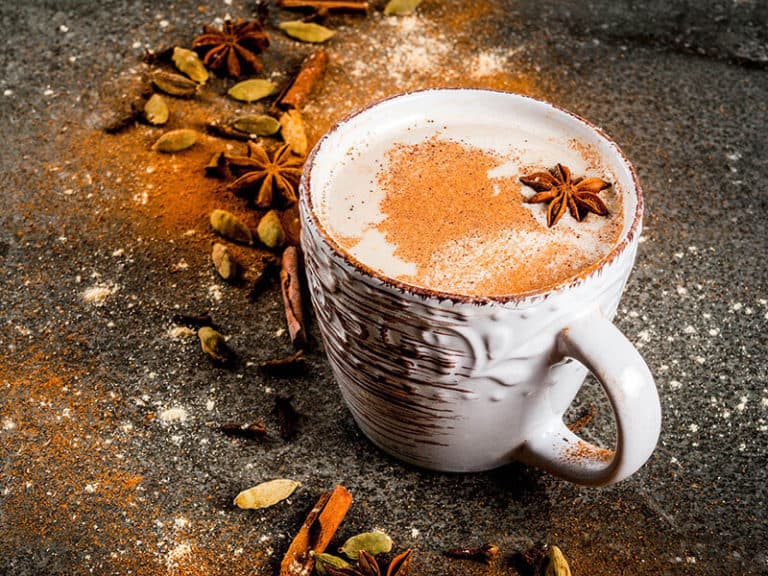
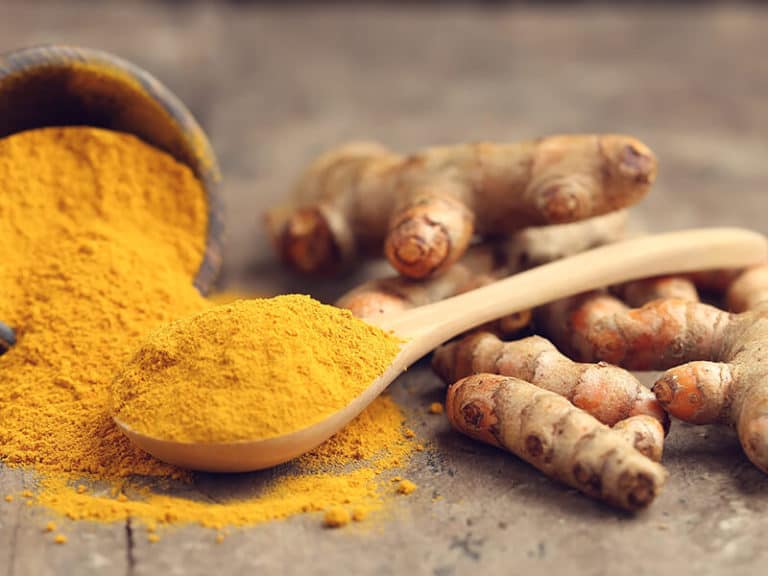
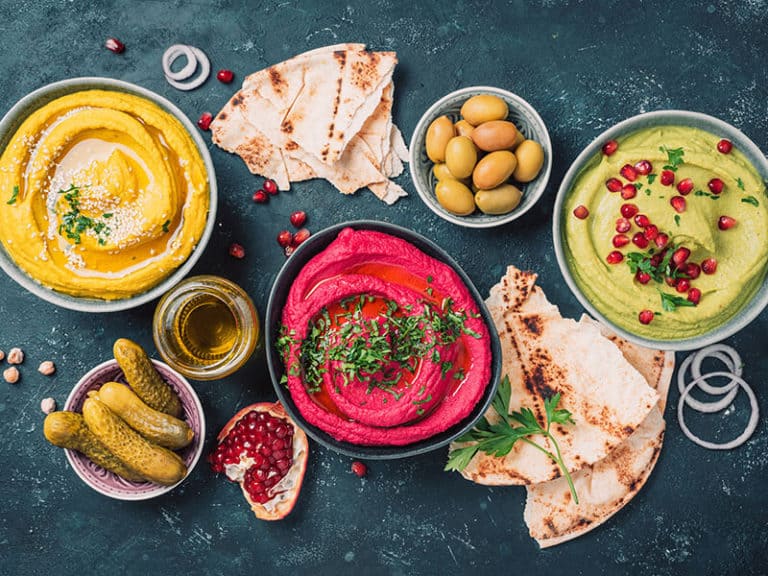


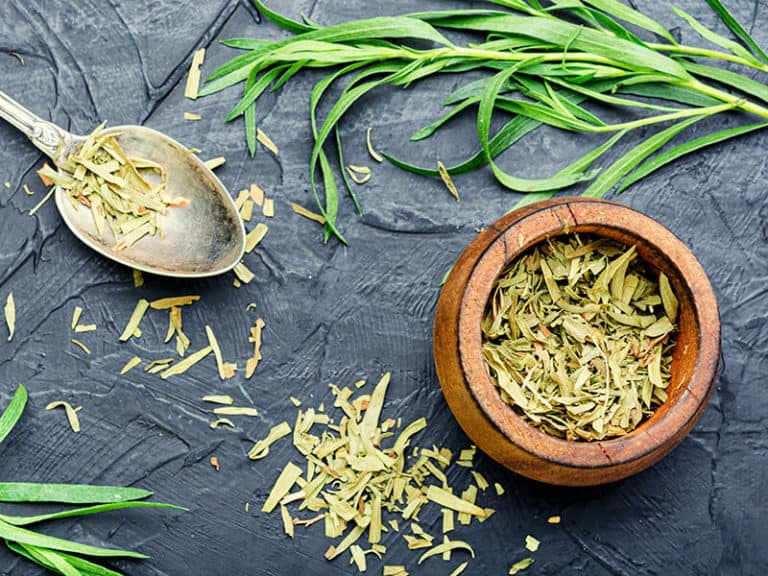
Amanda Collins
Founder and Senior Culinary Editor
Expertise
Culinary Arts and Management, Food Journalism and Critique, Recipe Development and Testing, Global Culinary Traditions, Sustainable Food Practices
Education
Institute of Culinary Education (ICE), New York, NY
Program: Diploma in Culinary Arts
Focus: Intensive hands-on training in culinary techniques, recipe development, and kitchen management, preparing students for professional roles in the culinary industry.
Monroe College, New Rochelle, NY
Program: Associate in Applied Science in Culinary Arts
Focus: Practical culinary skills, including cooking techniques, menu planning, and kitchen operations, with an emphasis on hands-on experience and industry standards.
Amanda Collins is a seasoned chef and food editor with a deep love for global flavors. Trained at the Institute of Culinary Education and Monroe College, and with over 15 years in the culinary field, Amanda has refined her skills in kitchens worldwide. Her background in food studies gives her a unique ability to share both recipes and the cultural stories that shape them.
As senior culinary editor at thebreslin.com, Amanda’s work brings authentic dishes to life, inviting readers to explore new flavors and techniques from around the globe. Her approachable style makes it easy for anyone to bring a bit of the world’s cuisine into their kitchen.